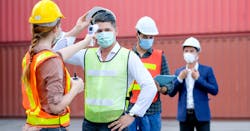A new year starts a new chapter in the mission of keeping the workplace safe. We have a new president, and both houses of Congress are now under the same party; there is new leadership at the Department of Labor (including OSHA) and the Department of Transportation (including the Federal Motor Carriers Safety Administration); new heads of the Environmental Protection Agency and the Food and Drug Administration; and in fact an entirely new regulatory mission on the part of the government when it comes to EHS matters.
However, we still have some of last year’s problems, chief among them catching COVID-19 and the fear of returning to the workplace. Convincing the entire U.S. population that it’s safe to go back into the workplace is not going to be easy, no matter how much in sync the Executive and Legislative branches of the government are aligned, and no matter how quickly vaccines are produced and administered. And it’s going to continue to be a daunting hurdle for every safety leader to confront the reality that some of their workers are not merely a little bit uneasy about going back into the workplace—they’re just plain scared.
There have been all sorts of polls and surveys conducted lately, asking people about their readiness and willingness to return to the workplace. Here are some recent findings:
• 54% of respondents who’ve been working from home during the pandemic say they’d prefer to continue doing so after the pandemic ends. Meanwhile, of those people who have had to report to their traditional workplace, 54% say they’re worried about being exposed to COVID-19 from their fellow workers (Pew Research Center).
• 38% say that would accept a 10% pay cut if it meant they could continue working at home (TalentLMS).
• 49% think that the pandemic in the United States is behind us, but 47% think that the worst is yet to come (CNN).
• 35% say they’re not willing to be vaccinated against the virus (Gallup).
An optimistic reading of those survey results would suggest that most people are hopeful that someday soon they’ll be looking at COVID-19 through their rearview mirror and their personal and work lives will have resumed some sense of pre-pandemic normalcy. A less-optimistic interpretation, however, is that a large number of people feel the entire world is still on “pause,” with no definable end in sight and rumors of a more contagious form of the virus prompting calls for people to start double-masking. No matter how you look at the survey results, one thing is beyond dispute: The role of EHS managers is only going to get even more intense, as workplace safety protocols continue to evolve, reflecting the new administration’s guidelines, the impact (or lack thereof) of vaccinations, and the insidious reluctance of the coronavirus to just go away already.
For those of you longing for “the good ol’ pre-COVID days” when we had other EHS-related things to talk about, I ventured into the EHS Today archives to see what I wrote in my column a year ago, the last one before the pandemic. Unfortunately, the topic I wrote about then was an equally disturbing subject: a 2% rise in workplace deaths from 2017 to 2018. I wish I could report that the latest annual tally from the U.S. Bureau of Labor Statistics shows an improvement, but that’s not the case. In 2019 (the BLS has always been a year behind in its reports, despite having access to the fastest computers and data analytics processors in the world), there was again a 2% increase in fatal work injuries compared to the previous year. In fact, there were 5,333 workplace fatalities in 2019, the largest annual number since 2007.
“With many safety advancements being readily available to employers nationwide, it’s troubling that we’re continuing to see higher numbers of worker fatalities,” said Deborah Roy, president of the American Society of Safety Professionals (ASSP). “Strong workplace cultures that bring together management and employees while including safety and health climates must become a priority for all companies and organizations.”
Echoing the ASSP, the National Safety Council (NSC) expressed its concern over the increase in fatalities, and added an “even more alarming” observation that these are pre-pandemic figures. “2020 data could be far bleaker given COVID-19’s impact on workplace safety,” the NSC cautioned.
Let’s hope the NSC is wrong, and that the heightened calls to the entire population to take safety very seriously will result in fewer workplace fatalities (although it’s unclear exactly how the BLS will determine if a COVID-related death should be considered a workplace fatality). But one thing is clear: Workers are very skittish right now about coming into the workplace, so the vigilance of EHS leaders will be vital to ensuring that we all are able to resume our work lives in safe and healthy environments.
About the Author

Dave Blanchard
Editor-in-Chief / Senior Director of Content
During his career Dave Blanchard has led the editorial management of many of Endeavor Business Media's best-known brands, including IndustryWeek, EHS Today, Material Handling & Logistics, Logistics Today, Supply Chain Technology News, and Business Finance. In addition, he serves as senior content director of the annual Safety Leadership Conference. With over 30 years of B2B media experience, Dave literally wrote the book on supply chain management, Supply Chain Management Best Practices (John Wiley & Sons, 2021), which has been translated into several languages and is currently in its third edition. Prior to joining Endeavor/Informa/Penton, he spent a decade covering the artificial intelligence industry. He is a frequent speaker and moderator at major trade shows and conferences, and has won numerous awards for writing and editing. He is a voting member of the jury of the Logistics Hall of Fame, and is a graduate of Northern Illinois University.
